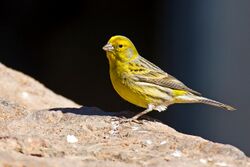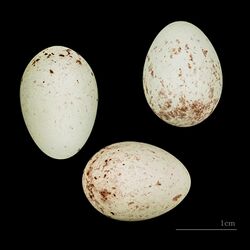Biology:Atlantic canary
| Atlantic canary | |
|---|---|

| |
| Male in Gran Canaria, Spain | |
| Scientific classification | |
| Domain: | Eukaryota |
| Kingdom: | Animalia |
| Phylum: | Chordata |
| Class: | Aves |
| Order: | Passeriformes |
| Family: | Fringillidae |
| Subfamily: | Carduelinae |
| Genus: | Serinus |
| Species: | S. canaria
|
| Binomial name | |
| Serinus canaria | |
| Synonyms | |
|
Fringilla canaria Linnaeus, 1758 | |
The Atlantic canary (Serinus canaria), known worldwide simply as the wild canary and also called the island canary, common canary, or canary, is a small passerine bird belonging to the genus Serinus in the true finch family, Fringillidae. It is native to the Canary Islands, the Azores, and Madeira. Wild birds are mostly yellow-green, with brownish streaking on the back. The species is common in captivity and a number of colour varieties have been bred.
This bird is the natural symbol of the Canary Islands, together with the Canary Island date palm.[2]
Description
The Atlantic canary can range from 10 to 12 cm (3.9 to 4.7 in) in length, with a wingspan of 21 to 23.7 cm (8.3 to 9.3 in) and a weight of 8.4 to 24.3 g (0.30 to 0.86 oz), with an average of around 15 g (0.53 oz).[3][4][5][6][7][8] The male has a largely yellow-green head and underparts with a yellower forehead, face and supercilium.[9] The lower belly and undertail-coverts are whitish and there are some dark streaks on the sides. The upperparts are grey-green with dark streaks and the rump is dull yellow.[10] The female is similar to the male but duller with a greyer head and breast and less yellow underparts. Juvenile birds are largely brown with dark streaks.
It is about 10% larger, longer and less contrasted than its relative the European serin, and has more grey and brown in its plumage and relatively shorter wings.[3]
The song is a silvery twittering similar to the songs of the European serin and citril finch.[3][9]
Taxonomy
The Atlantic canary was classified by Linnaeus in 1758 in his Systema Naturae. Linnaeus originally classified the Atlantic canary as a subspecies of the European serin and assigned them to the genus Fringilla. Decades later, Cuvier reclassified them into the genus Serinus and there they have remained. The Atlantic canary's closest relative is the European serin, and the two can produce on average 25% fertile hybrids if crossed.
Etymology
The bird is named after the Canary Islands, not the other way around. The islands' name is derived from the Latin name canariae insulae ("islands of dogs") used by Arnobius, referring to the large dogs kept by the inhabitants of the islands.[11] A legend of the islands, however, states that it was the conquistadors who named the islands after a fierce tribe inhabiting the largest island of the group, known as the 'Canarii'. The colour canary yellow is in turn named after the yellow domestic canary, produced by a mutation which suppressed the melanins of the original dull greenish wild Atlantic canary colour.
Distribution and habitat
It is endemic to the Canary Islands, Azores and Madeira in the region known as Macaronesia in the eastern Atlantic Ocean. In the Canary Islands, it is common on Tenerife, La Gomera, La Palma and El Hierro, but more local on Gran Canaria, and rare on Lanzarote and Fuerteventura, where it has only recently begun breeding.[10][12] It is common in Madeira including Porto Santo and the Desertas Islands, and has been recorded on the Salvage Islands. In the Azores, it is common on all islands.[10] The population has been estimated at 80,000-90,000 pairs in the Canary Islands, 30,000-60,000 pairs in the Azores and 4,000-5,000 pairs in Madeira.[3]
It occurs in a wide variety of habitats from pine and laurel forests to sand dunes. It is most common in semiopen areas with small trees such as orchards and copses. It frequently occurs in man-made habitats such as parks and gardens. It is found from sea-level up to at least 760 m in Madeira, 1,100 m in the Azores and to above 1,500 m in the Canary Islands.[3]
It has become established on Midway Atoll in the northwest Hawaiian Islands, where it was first introduced in 1911. It was also introduced to neighbouring Kure Atoll, but failed to become established there.[13] Birds were introduced to Bermuda in 1930 and quickly started breeding, but they began to decline in the 1940s after scale insects devastated the population of Bermuda cedar, and by the 1960s they had died out.[14] The species also occurs in Puerto Rico, but is not yet established there.[15]
Behavior
Reproduction
It is a gregarious bird which often nests in groups with each pair defending a small territory. The cup-shaped nest is built 1–6 m above the ground in a tree or bush, most commonly at 3–4 m.[10] It is well-hidden amongst leaves, often at the end of a branch or in a fork. It is made of twigs, grass, moss and other plant material and lined with soft material including hair and feathers.[3]
The eggs are laid between January and July in the Canary Islands, from March to June with a peak of April and May in Madeira and from March to July with a peak of May and June in the Azores. They are pale blue or blue-green with violet or reddish markings concentrated at the broad end. A clutch contains 3 to 4 or occasionally 5 eggs and 2-3 broods are raised each year. The eggs are incubated for 13–14 days and the young birds leave the nest after 14–21 days, most commonly after 15–17 days.[3]
Feeding
It typically feeds in flocks, foraging on the ground or amongst low vegetation. It mainly feeds on seeds such as those of weeds, grasses and figs. It also feeds on other plant material and small insects.[3]
See also
- List of animal and plant symbols of the Canary Islands
- Domestic canary
- Australian plainhead
- Harz Roller
- Red factor canary
References
- ↑ BirdLife International (2018). "Serinus canaria". IUCN Red List of Threatened Species 2018: e.T22720056A132137153. doi:10.2305/IUCN.UK.2018-2.RLTS.T22720056A132137153.en. https://www.iucnredlist.org/species/22720056/132137153. Retrieved 19 November 2021.
- ↑ "Símbolos de la naturaleza para las Islas Canarias" (in es). Ley No. 7/1991 of 30 April 1991. 151. pp. 20946–20497. https://www.boe.es/buscar/act.php?id=BOE-A-1991-16276.
- ↑ 3.0 3.1 3.2 3.3 3.4 3.5 3.6 3.7 Snow, D. W. & Perrins, C. M. (1998). The Birds of the Western Palearctic concise ed. Oxford University Press. ISBN:0-19-854099-X.
- ↑ "Tubeworm (Lamellibrachia) longevity, ageing, and life history". http://genomics.senescence.info/species/entry.php.
- ↑ "A Canary Is an Ideal Pet Bird for Beginners". https://www.thesprucepets.com/pet-canaries-1236727.
- ↑ "Rapid Radiation of Canaries". http://mbe.oxfordjournals.org/content/16/1/2.full.pdf.
- ↑ CRC Handbook of Avian Body Masses by John B. Dunning Jr. (Editor). CRC Press (1992), ISBN:978-0-8493-4258-5.
- ↑ Finches and Sparrows by Peter Clement. Princeton University Press (1999). ISBN:978-0691048789.
- ↑ 9.0 9.1 Clement, P., Harris, A., & and Davis, J. (1993). Finches and Sparrows. Helm ISBN:0-7136-8017-2.
- ↑ 10.0 10.1 10.2 10.3 Tony Clarke, Chris Orgill & Tony Dudley (2006) Field Guide to the Birds of the Atlantic Islands, Christopher Helm, London.
- ↑ Oxford English Dictionary
- ↑ Clarke, Tony & Collins, David (1996). A Birdwatchers' Guide to the Canary Islands. Prion, Huntingdon. ISBN:1-871104-06-8.
- ↑ Pratt, H. Douglas; Bruner, Philip L. & Berrett, Delwyn G. (1987). A Field Guide to the Birds of Hawaii and the Tropical Pacific, Princeton University Press, Chichester.
- ↑ Amos, Eric J. R. (1991). A guide to the Birds of Bermuda.
- ↑ American Ornithologists Union (1998). Checklist of North American Birds , 7th ed.
External links
| Wikimedia Commons has media related to Atlantic canary. |
| Wikisource has the text of the 1911 Encyclopædia Britannica article Canary. |
- Canary videos, photos & sounds on the Internet Bird Collection
Wikidata ☰ Q192524 entry
 |




